Epidemiology Research Critique: Western Australia Breast Cancer Study
VerifiedAdded on 2022/10/01
|12
|2872
|383
Report
AI Summary
This report presents a comprehensive critique of a population-based case-control study that investigated the association between breast cancer and three sleep domains among women in Western Australia. The critique evaluates the study's title, abstract, keywords, introduction, aims, methods, results, discussion, and conclusions. The report highlights the study's strengths, such as its clear title, elaborate introduction, and appropriate selection of participants. The study employed a case-control design, comparing cases with breast cancer to controls. The critique examines the study's methodology, including the use of self-reported questionnaires and statistical analyses. The report also discusses the study's findings, which indicated no statistically significant association between sleep determinants and breast cancer. The critique concludes with a discussion of the study's limitations and implications, emphasizing the need for further research to confirm the findings and explore the complex relationship between sleep and breast cancer risk. The study's findings showing absence of association between variables is noted to well correlate with tho findings of several studies indicating similar lack of association.
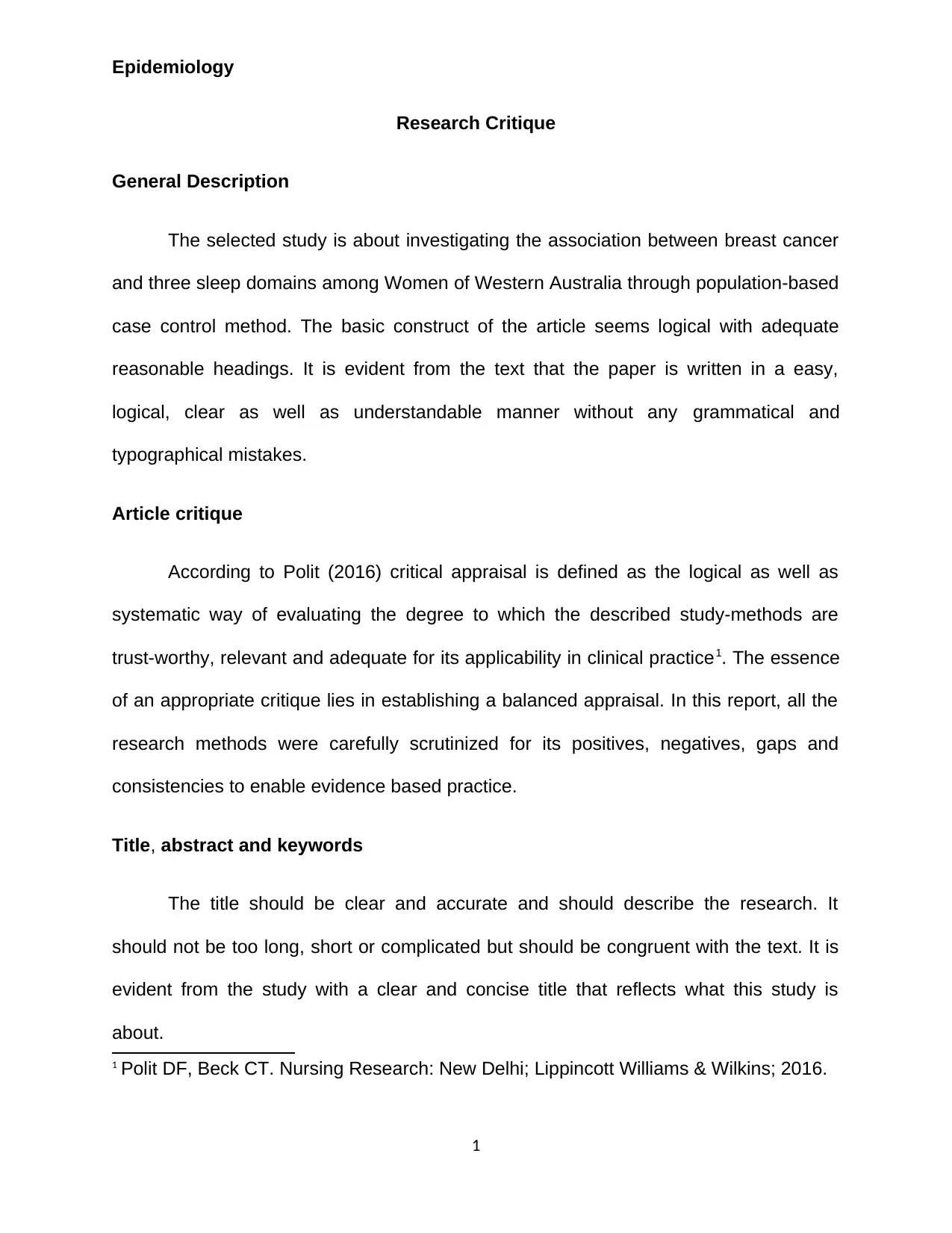
Epidemiology
Research Critique
General Description
The selected study is about investigating the association between breast cancer
and three sleep domains among Women of Western Australia through population-based
case control method. The basic construct of the article seems logical with adequate
reasonable headings. It is evident from the text that the paper is written in a easy,
logical, clear as well as understandable manner without any grammatical and
typographical mistakes.
Article critique
According to Polit (2016) critical appraisal is defined as the logical as well as
systematic way of evaluating the degree to which the described study-methods are
trust-worthy, relevant and adequate for its applicability in clinical practice1. The essence
of an appropriate critique lies in establishing a balanced appraisal. In this report, all the
research methods were carefully scrutinized for its positives, negatives, gaps and
consistencies to enable evidence based practice.
Title, abstract and keywords
The title should be clear and accurate and should describe the research. It
should not be too long, short or complicated but should be congruent with the text. It is
evident from the study with a clear and concise title that reflects what this study is
about.
1 Polit DF, Beck CT. Nursing Research: New Delhi; Lippincott Williams & Wilkins; 2016.
1
Research Critique
General Description
The selected study is about investigating the association between breast cancer
and three sleep domains among Women of Western Australia through population-based
case control method. The basic construct of the article seems logical with adequate
reasonable headings. It is evident from the text that the paper is written in a easy,
logical, clear as well as understandable manner without any grammatical and
typographical mistakes.
Article critique
According to Polit (2016) critical appraisal is defined as the logical as well as
systematic way of evaluating the degree to which the described study-methods are
trust-worthy, relevant and adequate for its applicability in clinical practice1. The essence
of an appropriate critique lies in establishing a balanced appraisal. In this report, all the
research methods were carefully scrutinized for its positives, negatives, gaps and
consistencies to enable evidence based practice.
Title, abstract and keywords
The title should be clear and accurate and should describe the research. It
should not be too long, short or complicated but should be congruent with the text. It is
evident from the study with a clear and concise title that reflects what this study is
about.
1 Polit DF, Beck CT. Nursing Research: New Delhi; Lippincott Williams & Wilkins; 2016.
1
Paraphrase This Document
Need a fresh take? Get an instant paraphrase of this document with our AI Paraphraser
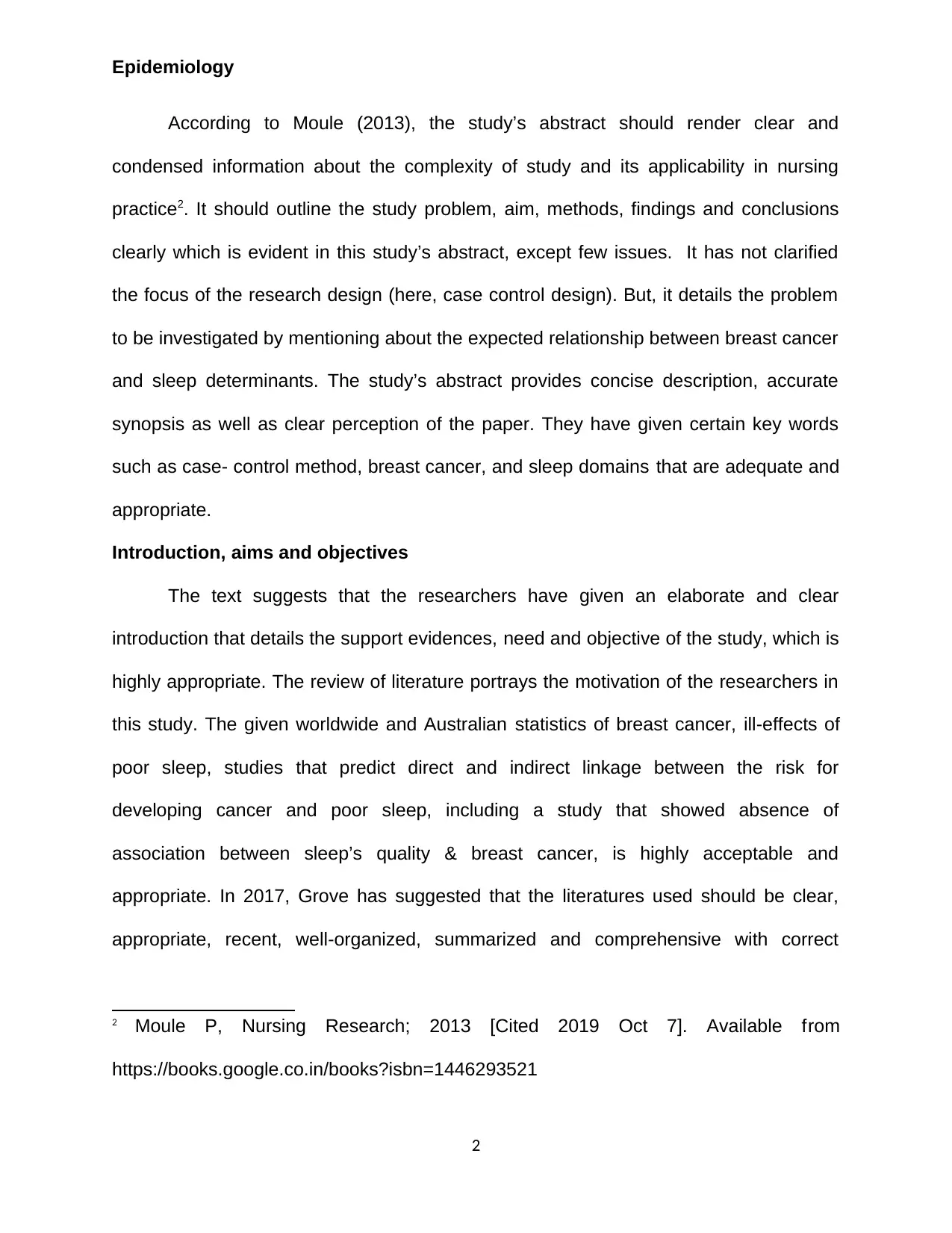
Epidemiology
According to Moule (2013), the study’s abstract should render clear and
condensed information about the complexity of study and its applicability in nursing
practice2. It should outline the study problem, aim, methods, findings and conclusions
clearly which is evident in this study’s abstract, except few issues. It has not clarified
the focus of the research design (here, case control design). But, it details the problem
to be investigated by mentioning about the expected relationship between breast cancer
and sleep determinants. The study’s abstract provides concise description, accurate
synopsis as well as clear perception of the paper. They have given certain key words
such as case- control method, breast cancer, and sleep domains that are adequate and
appropriate.
Introduction, aims and objectives
The text suggests that the researchers have given an elaborate and clear
introduction that details the support evidences, need and objective of the study, which is
highly appropriate. The review of literature portrays the motivation of the researchers in
this study. The given worldwide and Australian statistics of breast cancer, ill-effects of
poor sleep, studies that predict direct and indirect linkage between the risk for
developing cancer and poor sleep, including a study that showed absence of
association between sleep’s quality & breast cancer, is highly acceptable and
appropriate. In 2017, Grove has suggested that the literatures used should be clear,
appropriate, recent, well-organized, summarized and comprehensive with correct
2 Moule P, Nursing Research; 2013 [Cited 2019 Oct 7]. Available from
https://books.google.co.in/books?isbn=1446293521
2
According to Moule (2013), the study’s abstract should render clear and
condensed information about the complexity of study and its applicability in nursing
practice2. It should outline the study problem, aim, methods, findings and conclusions
clearly which is evident in this study’s abstract, except few issues. It has not clarified
the focus of the research design (here, case control design). But, it details the problem
to be investigated by mentioning about the expected relationship between breast cancer
and sleep determinants. The study’s abstract provides concise description, accurate
synopsis as well as clear perception of the paper. They have given certain key words
such as case- control method, breast cancer, and sleep domains that are adequate and
appropriate.
Introduction, aims and objectives
The text suggests that the researchers have given an elaborate and clear
introduction that details the support evidences, need and objective of the study, which is
highly appropriate. The review of literature portrays the motivation of the researchers in
this study. The given worldwide and Australian statistics of breast cancer, ill-effects of
poor sleep, studies that predict direct and indirect linkage between the risk for
developing cancer and poor sleep, including a study that showed absence of
association between sleep’s quality & breast cancer, is highly acceptable and
appropriate. In 2017, Grove has suggested that the literatures used should be clear,
appropriate, recent, well-organized, summarized and comprehensive with correct
2 Moule P, Nursing Research; 2013 [Cited 2019 Oct 7]. Available from
https://books.google.co.in/books?isbn=1446293521
2
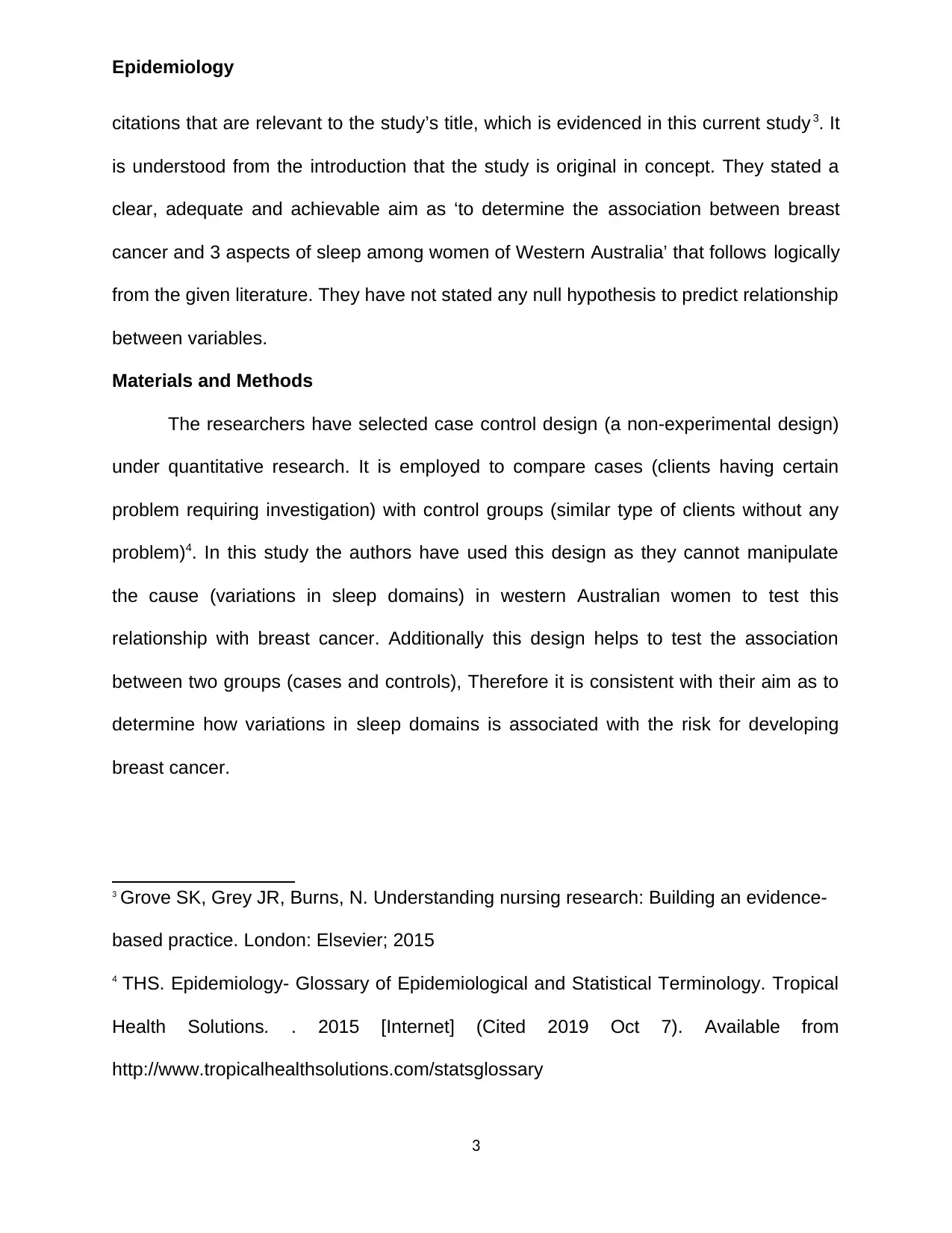
Epidemiology
citations that are relevant to the study’s title, which is evidenced in this current study 3. It
is understood from the introduction that the study is original in concept. They stated a
clear, adequate and achievable aim as ‘to determine the association between breast
cancer and 3 aspects of sleep among women of Western Australia’ that follows logically
from the given literature. They have not stated any null hypothesis to predict relationship
between variables.
Materials and Methods
The researchers have selected case control design (a non-experimental design)
under quantitative research. It is employed to compare cases (clients having certain
problem requiring investigation) with control groups (similar type of clients without any
problem)4. In this study the authors have used this design as they cannot manipulate
the cause (variations in sleep domains) in western Australian women to test this
relationship with breast cancer. Additionally this design helps to test the association
between two groups (cases and controls), Therefore it is consistent with their aim as to
determine how variations in sleep domains is associated with the risk for developing
breast cancer.
3 Grove SK, Grey JR, Burns, N. Understanding nursing research: Building an evidence-
based practice. London: Elsevier; 2015
4 THS. Epidemiology- Glossary of Epidemiological and Statistical Terminology. Tropical
Health Solutions. . 2015 [Internet] (Cited 2019 Oct 7). Available from
http://www.tropicalhealthsolutions.com/statsglossary
3
citations that are relevant to the study’s title, which is evidenced in this current study 3. It
is understood from the introduction that the study is original in concept. They stated a
clear, adequate and achievable aim as ‘to determine the association between breast
cancer and 3 aspects of sleep among women of Western Australia’ that follows logically
from the given literature. They have not stated any null hypothesis to predict relationship
between variables.
Materials and Methods
The researchers have selected case control design (a non-experimental design)
under quantitative research. It is employed to compare cases (clients having certain
problem requiring investigation) with control groups (similar type of clients without any
problem)4. In this study the authors have used this design as they cannot manipulate
the cause (variations in sleep domains) in western Australian women to test this
relationship with breast cancer. Additionally this design helps to test the association
between two groups (cases and controls), Therefore it is consistent with their aim as to
determine how variations in sleep domains is associated with the risk for developing
breast cancer.
3 Grove SK, Grey JR, Burns, N. Understanding nursing research: Building an evidence-
based practice. London: Elsevier; 2015
4 THS. Epidemiology- Glossary of Epidemiological and Statistical Terminology. Tropical
Health Solutions. . 2015 [Internet] (Cited 2019 Oct 7). Available from
http://www.tropicalhealthsolutions.com/statsglossary
3
⊘ This is a preview!⊘
Do you want full access?
Subscribe today to unlock all pages.

Trusted by 1+ million students worldwide
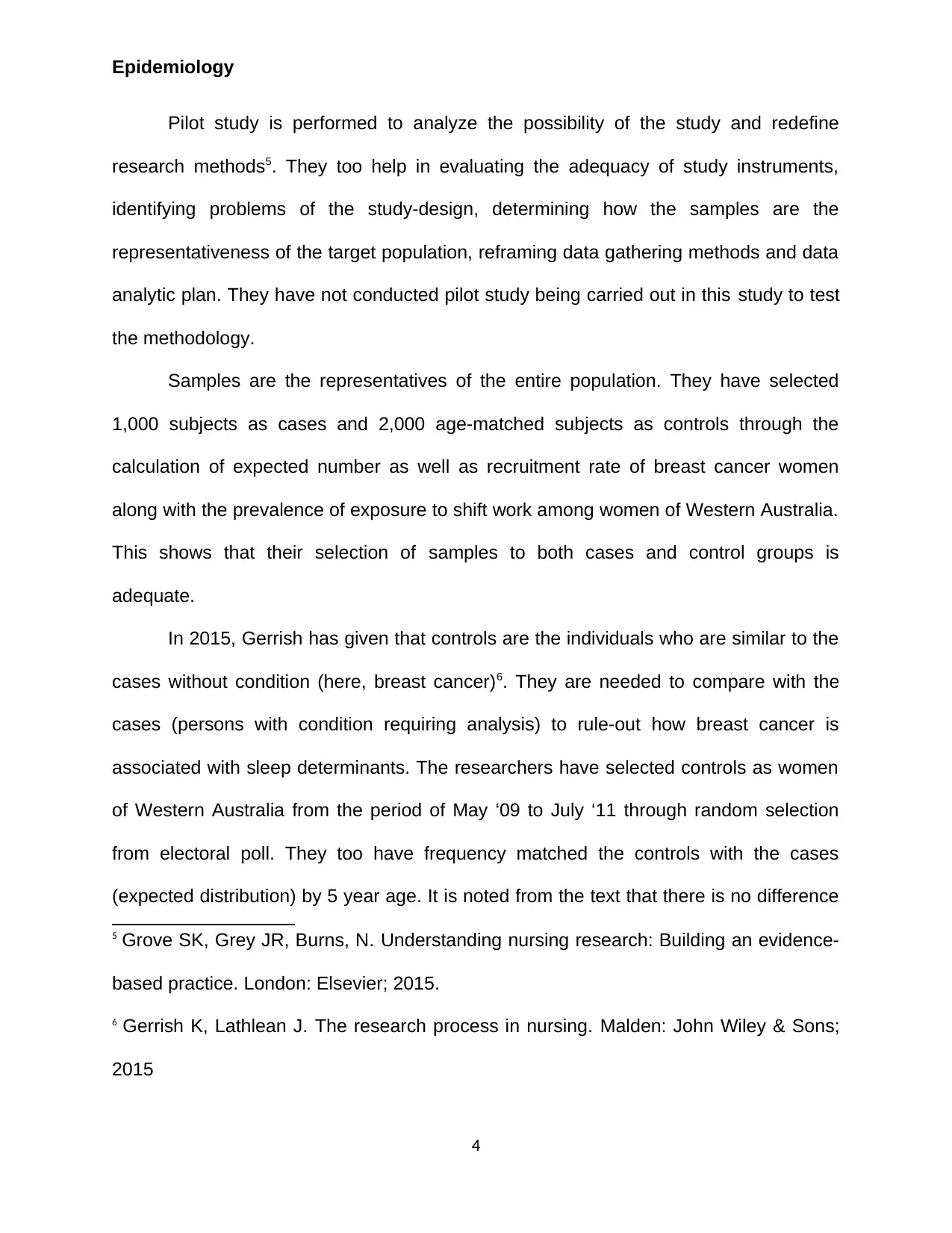
Epidemiology
Pilot study is performed to analyze the possibility of the study and redefine
research methods5. They too help in evaluating the adequacy of study instruments,
identifying problems of the study-design, determining how the samples are the
representativeness of the target population, reframing data gathering methods and data
analytic plan. They have not conducted pilot study being carried out in this study to test
the methodology.
Samples are the representatives of the entire population. They have selected
1,000 subjects as cases and 2,000 age-matched subjects as controls through the
calculation of expected number as well as recruitment rate of breast cancer women
along with the prevalence of exposure to shift work among women of Western Australia.
This shows that their selection of samples to both cases and control groups is
adequate.
In 2015, Gerrish has given that controls are the individuals who are similar to the
cases without condition (here, breast cancer)6. They are needed to compare with the
cases (persons with condition requiring analysis) to rule-out how breast cancer is
associated with sleep determinants. The researchers have selected controls as women
of Western Australia from the period of May ‘09 to July ‘11 through random selection
from electoral poll. They too have frequency matched the controls with the cases
(expected distribution) by 5 year age. It is noted from the text that there is no difference
5 Grove SK, Grey JR, Burns, N. Understanding nursing research: Building an evidence-
based practice. London: Elsevier; 2015.
6 Gerrish K, Lathlean J. The research process in nursing. Malden: John Wiley & Sons;
2015
4
Pilot study is performed to analyze the possibility of the study and redefine
research methods5. They too help in evaluating the adequacy of study instruments,
identifying problems of the study-design, determining how the samples are the
representativeness of the target population, reframing data gathering methods and data
analytic plan. They have not conducted pilot study being carried out in this study to test
the methodology.
Samples are the representatives of the entire population. They have selected
1,000 subjects as cases and 2,000 age-matched subjects as controls through the
calculation of expected number as well as recruitment rate of breast cancer women
along with the prevalence of exposure to shift work among women of Western Australia.
This shows that their selection of samples to both cases and control groups is
adequate.
In 2015, Gerrish has given that controls are the individuals who are similar to the
cases without condition (here, breast cancer)6. They are needed to compare with the
cases (persons with condition requiring analysis) to rule-out how breast cancer is
associated with sleep determinants. The researchers have selected controls as women
of Western Australia from the period of May ‘09 to July ‘11 through random selection
from electoral poll. They too have frequency matched the controls with the cases
(expected distribution) by 5 year age. It is noted from the text that there is no difference
5 Grove SK, Grey JR, Burns, N. Understanding nursing research: Building an evidence-
based practice. London: Elsevier; 2015.
6 Gerrish K, Lathlean J. The research process in nursing. Malden: John Wiley & Sons;
2015
4
Paraphrase This Document
Need a fresh take? Get an instant paraphrase of this document with our AI Paraphraser
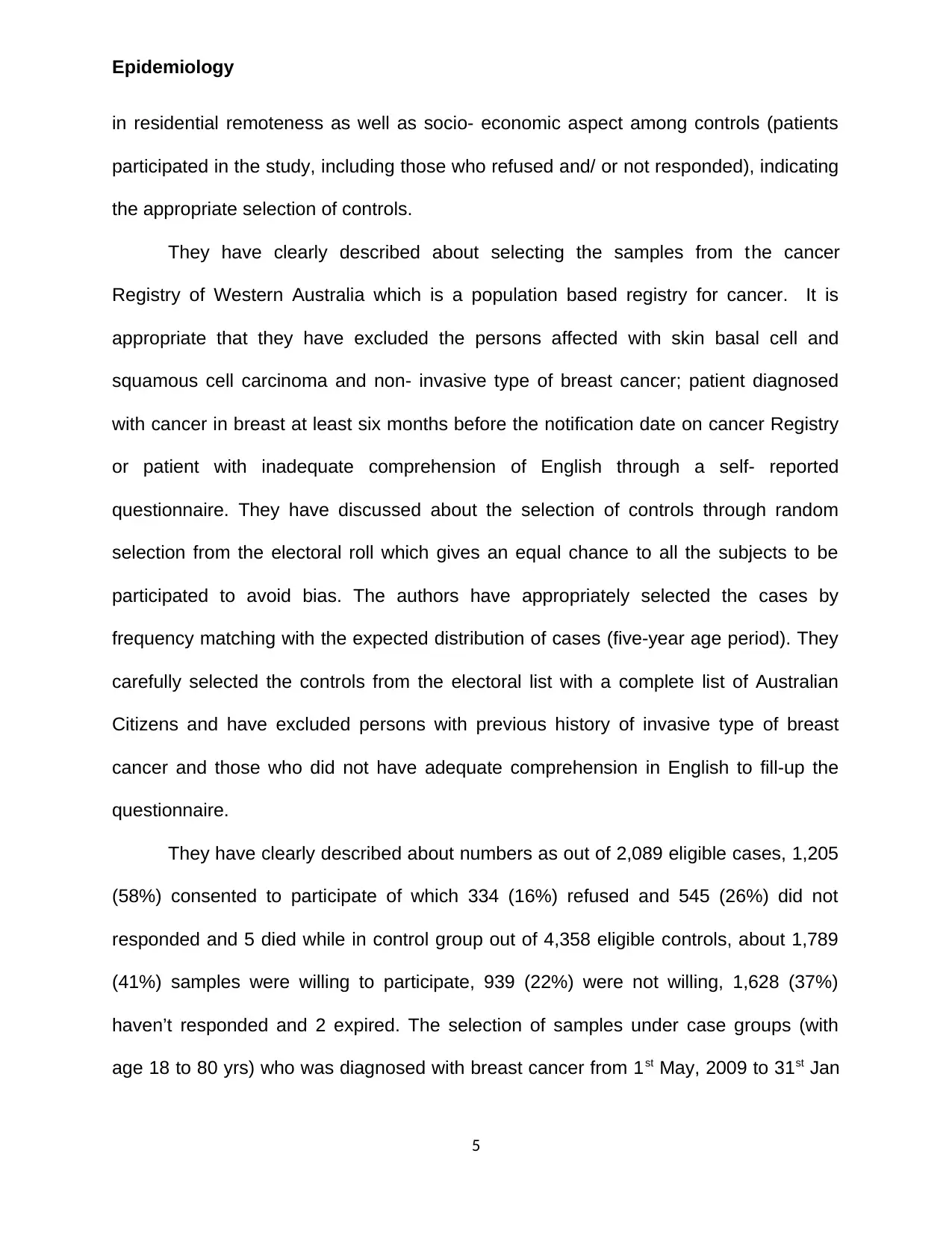
Epidemiology
in residential remoteness as well as socio- economic aspect among controls (patients
participated in the study, including those who refused and/ or not responded), indicating
the appropriate selection of controls.
They have clearly described about selecting the samples from the cancer
Registry of Western Australia which is a population based registry for cancer. It is
appropriate that they have excluded the persons affected with skin basal cell and
squamous cell carcinoma and non- invasive type of breast cancer; patient diagnosed
with cancer in breast at least six months before the notification date on cancer Registry
or patient with inadequate comprehension of English through a self- reported
questionnaire. They have discussed about the selection of controls through random
selection from the electoral roll which gives an equal chance to all the subjects to be
participated to avoid bias. The authors have appropriately selected the cases by
frequency matching with the expected distribution of cases (five-year age period). They
carefully selected the controls from the electoral list with a complete list of Australian
Citizens and have excluded persons with previous history of invasive type of breast
cancer and those who did not have adequate comprehension in English to fill-up the
questionnaire.
They have clearly described about numbers as out of 2,089 eligible cases, 1,205
(58%) consented to participate of which 334 (16%) refused and 545 (26%) did not
responded and 5 died while in control group out of 4,358 eligible controls, about 1,789
(41%) samples were willing to participate, 939 (22%) were not willing, 1,628 (37%)
haven’t responded and 2 expired. The selection of samples under case groups (with
age 18 to 80 yrs) who was diagnosed with breast cancer from 1st May, 2009 to 31st Jan
5
in residential remoteness as well as socio- economic aspect among controls (patients
participated in the study, including those who refused and/ or not responded), indicating
the appropriate selection of controls.
They have clearly described about selecting the samples from the cancer
Registry of Western Australia which is a population based registry for cancer. It is
appropriate that they have excluded the persons affected with skin basal cell and
squamous cell carcinoma and non- invasive type of breast cancer; patient diagnosed
with cancer in breast at least six months before the notification date on cancer Registry
or patient with inadequate comprehension of English through a self- reported
questionnaire. They have discussed about the selection of controls through random
selection from the electoral roll which gives an equal chance to all the subjects to be
participated to avoid bias. The authors have appropriately selected the cases by
frequency matching with the expected distribution of cases (five-year age period). They
carefully selected the controls from the electoral list with a complete list of Australian
Citizens and have excluded persons with previous history of invasive type of breast
cancer and those who did not have adequate comprehension in English to fill-up the
questionnaire.
They have clearly described about numbers as out of 2,089 eligible cases, 1,205
(58%) consented to participate of which 334 (16%) refused and 545 (26%) did not
responded and 5 died while in control group out of 4,358 eligible controls, about 1,789
(41%) samples were willing to participate, 939 (22%) were not willing, 1,628 (37%)
haven’t responded and 2 expired. The selection of samples under case groups (with
age 18 to 80 yrs) who was diagnosed with breast cancer from 1st May, 2009 to 31st Jan
5
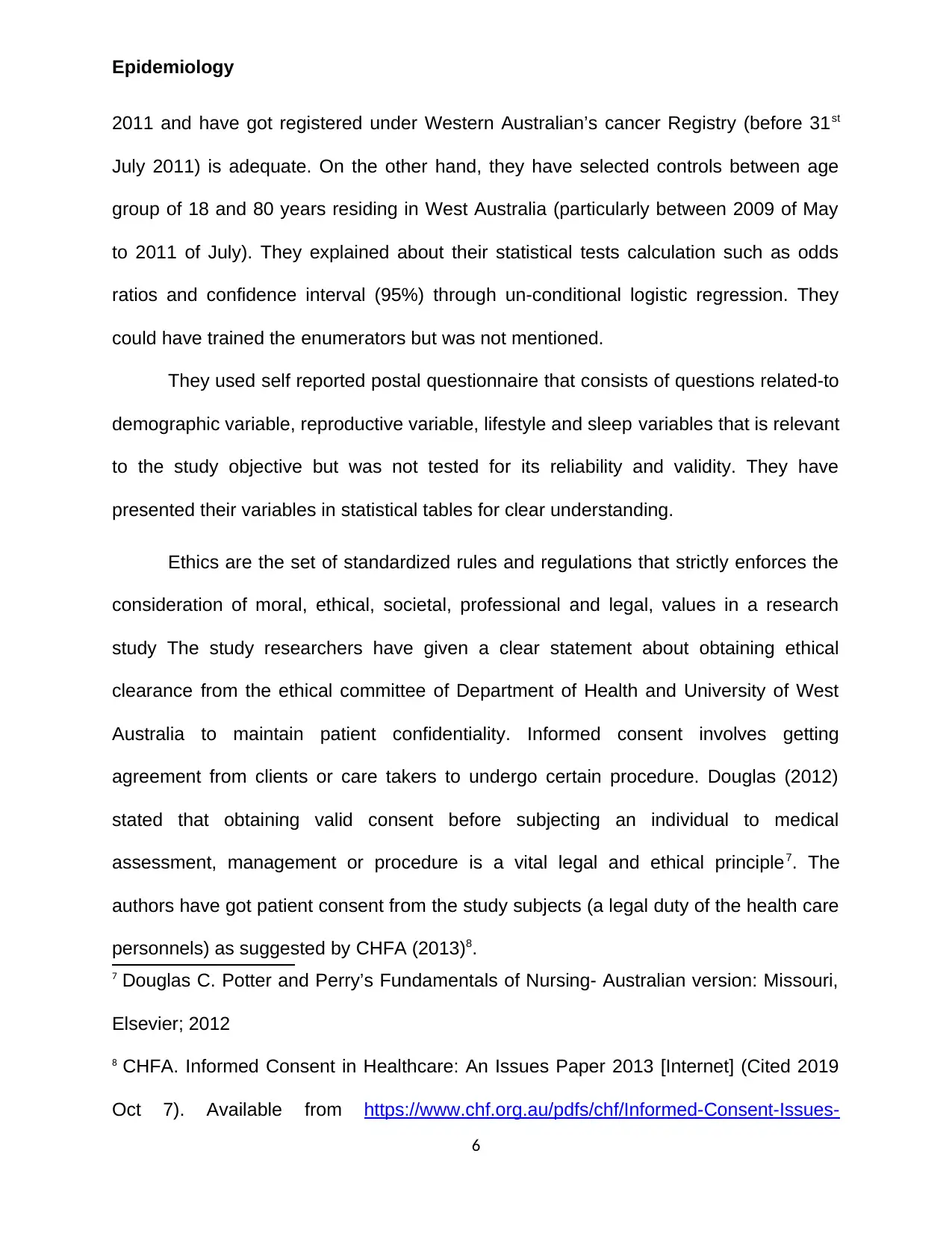
Epidemiology
2011 and have got registered under Western Australian’s cancer Registry (before 31st
July 2011) is adequate. On the other hand, they have selected controls between age
group of 18 and 80 years residing in West Australia (particularly between 2009 of May
to 2011 of July). They explained about their statistical tests calculation such as odds
ratios and confidence interval (95%) through un-conditional logistic regression. They
could have trained the enumerators but was not mentioned.
They used self reported postal questionnaire that consists of questions related-to
demographic variable, reproductive variable, lifestyle and sleep variables that is relevant
to the study objective but was not tested for its reliability and validity. They have
presented their variables in statistical tables for clear understanding.
Ethics are the set of standardized rules and regulations that strictly enforces the
consideration of moral, ethical, societal, professional and legal, values in a research
study The study researchers have given a clear statement about obtaining ethical
clearance from the ethical committee of Department of Health and University of West
Australia to maintain patient confidentiality. Informed consent involves getting
agreement from clients or care takers to undergo certain procedure. Douglas (2012)
stated that obtaining valid consent before subjecting an individual to medical
assessment, management or procedure is a vital legal and ethical principle7. The
authors have got patient consent from the study subjects (a legal duty of the health care
personnels) as suggested by CHFA (2013)8.
7 Douglas C. Potter and Perry’s Fundamentals of Nursing- Australian version: Missouri,
Elsevier; 2012
8 CHFA. Informed Consent in Healthcare: An Issues Paper 2013 [Internet] (Cited 2019
Oct 7). Available from https://www.chf.org.au/pdfs/chf/Informed-Consent-Issues-
6
2011 and have got registered under Western Australian’s cancer Registry (before 31st
July 2011) is adequate. On the other hand, they have selected controls between age
group of 18 and 80 years residing in West Australia (particularly between 2009 of May
to 2011 of July). They explained about their statistical tests calculation such as odds
ratios and confidence interval (95%) through un-conditional logistic regression. They
could have trained the enumerators but was not mentioned.
They used self reported postal questionnaire that consists of questions related-to
demographic variable, reproductive variable, lifestyle and sleep variables that is relevant
to the study objective but was not tested for its reliability and validity. They have
presented their variables in statistical tables for clear understanding.
Ethics are the set of standardized rules and regulations that strictly enforces the
consideration of moral, ethical, societal, professional and legal, values in a research
study The study researchers have given a clear statement about obtaining ethical
clearance from the ethical committee of Department of Health and University of West
Australia to maintain patient confidentiality. Informed consent involves getting
agreement from clients or care takers to undergo certain procedure. Douglas (2012)
stated that obtaining valid consent before subjecting an individual to medical
assessment, management or procedure is a vital legal and ethical principle7. The
authors have got patient consent from the study subjects (a legal duty of the health care
personnels) as suggested by CHFA (2013)8.
7 Douglas C. Potter and Perry’s Fundamentals of Nursing- Australian version: Missouri,
Elsevier; 2012
8 CHFA. Informed Consent in Healthcare: An Issues Paper 2013 [Internet] (Cited 2019
Oct 7). Available from https://www.chf.org.au/pdfs/chf/Informed-Consent-Issues-
6
⊘ This is a preview!⊘
Do you want full access?
Subscribe today to unlock all pages.

Trusted by 1+ million students worldwide
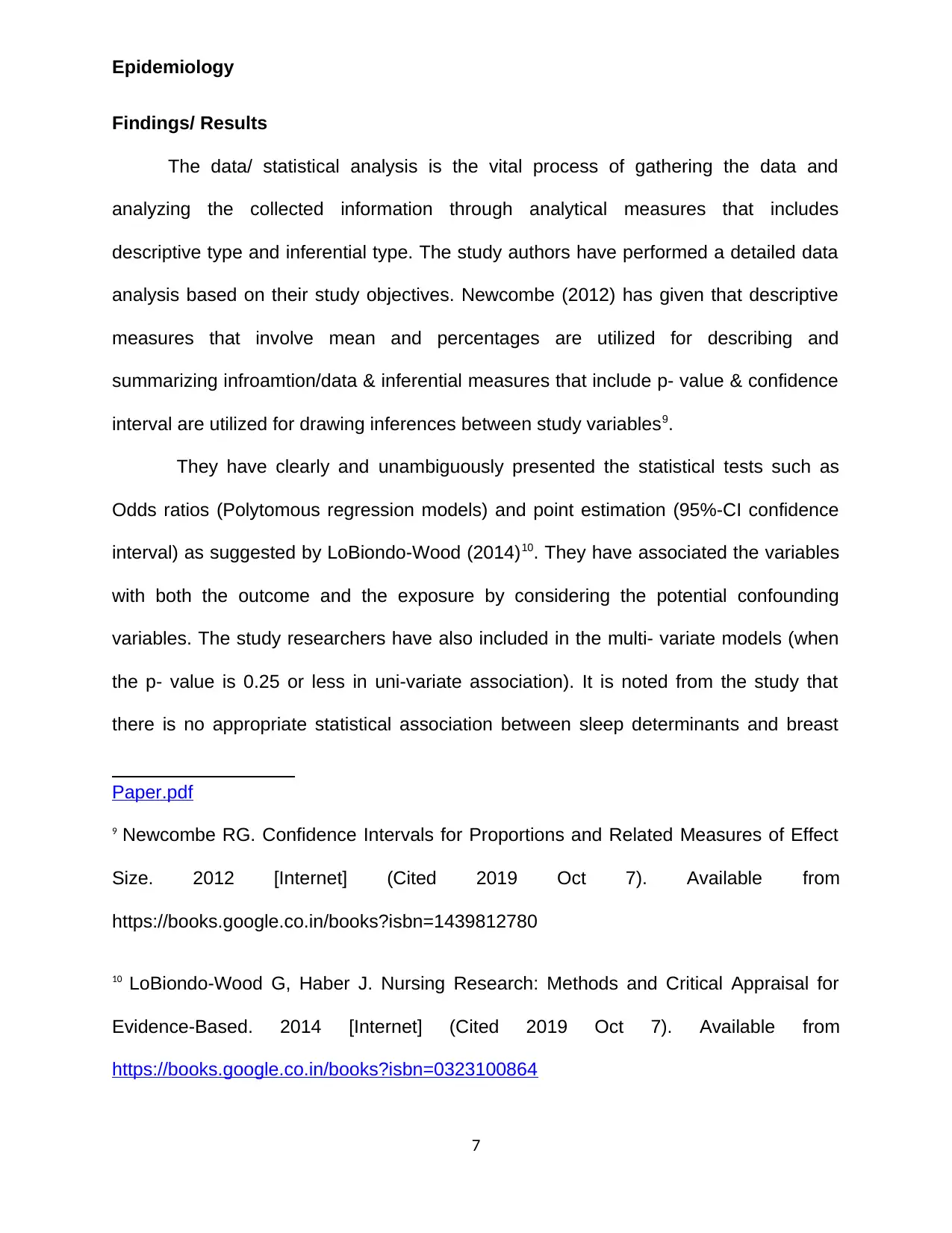
Epidemiology
Findings/ Results
The data/ statistical analysis is the vital process of gathering the data and
analyzing the collected information through analytical measures that includes
descriptive type and inferential type. The study authors have performed a detailed data
analysis based on their study objectives. Newcombe (2012) has given that descriptive
measures that involve mean and percentages are utilized for describing and
summarizing infroamtion/data & inferential measures that include p- value & confidence
interval are utilized for drawing inferences between study variables9.
They have clearly and unambiguously presented the statistical tests such as
Odds ratios (Polytomous regression models) and point estimation (95%-CI confidence
interval) as suggested by LoBiondo-Wood (2014)10. They have associated the variables
with both the outcome and the exposure by considering the potential confounding
variables. The study researchers have also included in the multi- variate models (when
the p- value is 0.25 or less in uni-variate association). It is noted from the study that
there is no appropriate statistical association between sleep determinants and breast
Paper.pdf
9 Newcombe RG. Confidence Intervals for Proportions and Related Measures of Effect
Size. 2012 [Internet] (Cited 2019 Oct 7). Available from
https://books.google.co.in/books?isbn=1439812780
10 LoBiondo-Wood G, Haber J. Nursing Research: Methods and Critical Appraisal for
Evidence-Based. 2014 [Internet] (Cited 2019 Oct 7). Available from
https://books.google.co.in/books?isbn=0323100864
7
Findings/ Results
The data/ statistical analysis is the vital process of gathering the data and
analyzing the collected information through analytical measures that includes
descriptive type and inferential type. The study authors have performed a detailed data
analysis based on their study objectives. Newcombe (2012) has given that descriptive
measures that involve mean and percentages are utilized for describing and
summarizing infroamtion/data & inferential measures that include p- value & confidence
interval are utilized for drawing inferences between study variables9.
They have clearly and unambiguously presented the statistical tests such as
Odds ratios (Polytomous regression models) and point estimation (95%-CI confidence
interval) as suggested by LoBiondo-Wood (2014)10. They have associated the variables
with both the outcome and the exposure by considering the potential confounding
variables. The study researchers have also included in the multi- variate models (when
the p- value is 0.25 or less in uni-variate association). It is noted from the study that
there is no appropriate statistical association between sleep determinants and breast
Paper.pdf
9 Newcombe RG. Confidence Intervals for Proportions and Related Measures of Effect
Size. 2012 [Internet] (Cited 2019 Oct 7). Available from
https://books.google.co.in/books?isbn=1439812780
10 LoBiondo-Wood G, Haber J. Nursing Research: Methods and Critical Appraisal for
Evidence-Based. 2014 [Internet] (Cited 2019 Oct 7). Available from
https://books.google.co.in/books?isbn=0323100864
7
Paraphrase This Document
Need a fresh take? Get an instant paraphrase of this document with our AI Paraphraser
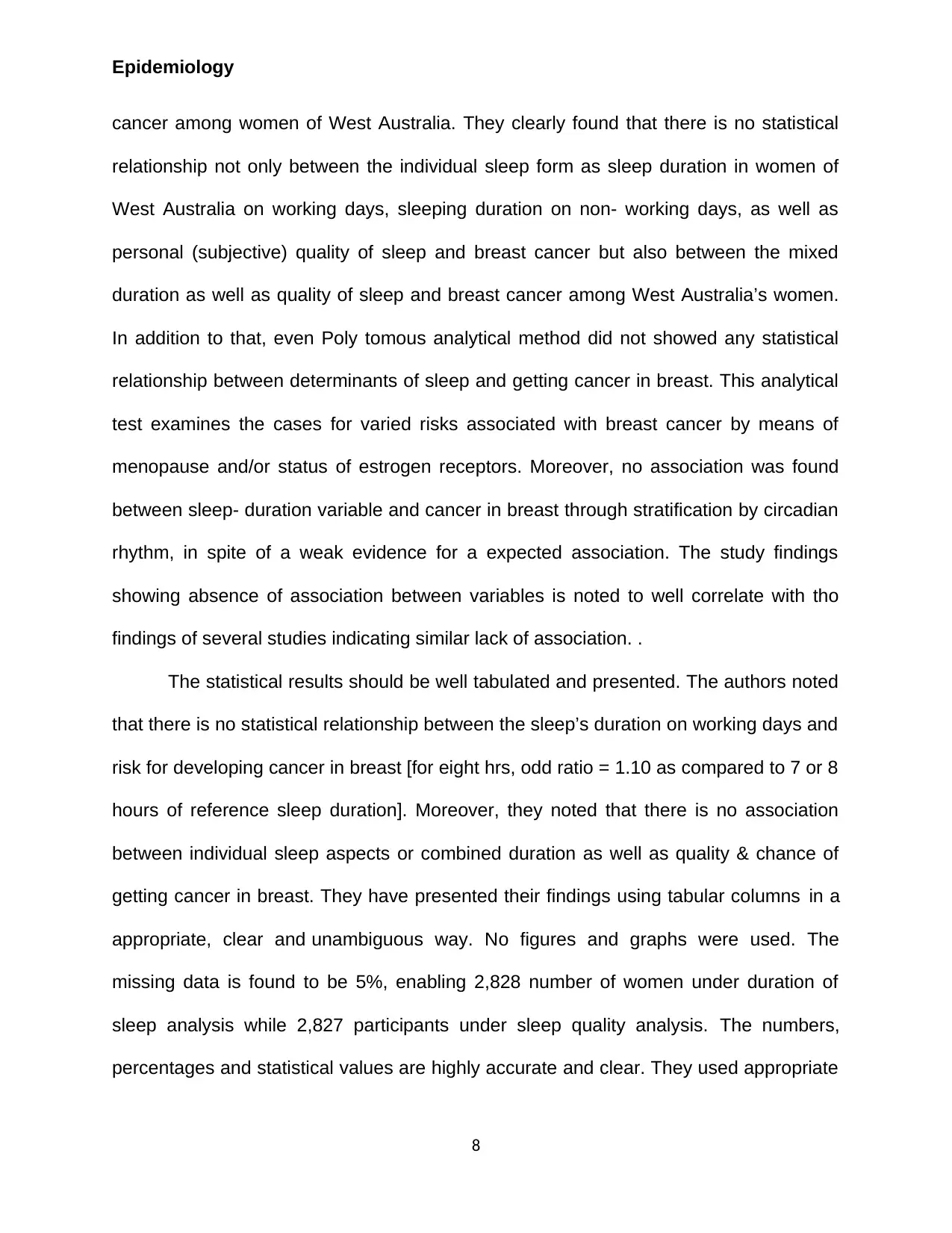
Epidemiology
cancer among women of West Australia. They clearly found that there is no statistical
relationship not only between the individual sleep form as sleep duration in women of
West Australia on working days, sleeping duration on non- working days, as well as
personal (subjective) quality of sleep and breast cancer but also between the mixed
duration as well as quality of sleep and breast cancer among West Australia’s women.
In addition to that, even Poly tomous analytical method did not showed any statistical
relationship between determinants of sleep and getting cancer in breast. This analytical
test examines the cases for varied risks associated with breast cancer by means of
menopause and/or status of estrogen receptors. Moreover, no association was found
between sleep- duration variable and cancer in breast through stratification by circadian
rhythm, in spite of a weak evidence for a expected association. The study findings
showing absence of association between variables is noted to well correlate with tho
findings of several studies indicating similar lack of association. .
The statistical results should be well tabulated and presented. The authors noted
that there is no statistical relationship between the sleep’s duration on working days and
risk for developing cancer in breast [for eight hrs, odd ratio = 1.10 as compared to 7 or 8
hours of reference sleep duration]. Moreover, they noted that there is no association
between individual sleep aspects or combined duration as well as quality & chance of
getting cancer in breast. They have presented their findings using tabular columns in a
appropriate, clear and unambiguous way. No figures and graphs were used. The
missing data is found to be 5%, enabling 2,828 number of women under duration of
sleep analysis while 2,827 participants under sleep quality analysis. The numbers,
percentages and statistical values are highly accurate and clear. They used appropriate
8
cancer among women of West Australia. They clearly found that there is no statistical
relationship not only between the individual sleep form as sleep duration in women of
West Australia on working days, sleeping duration on non- working days, as well as
personal (subjective) quality of sleep and breast cancer but also between the mixed
duration as well as quality of sleep and breast cancer among West Australia’s women.
In addition to that, even Poly tomous analytical method did not showed any statistical
relationship between determinants of sleep and getting cancer in breast. This analytical
test examines the cases for varied risks associated with breast cancer by means of
menopause and/or status of estrogen receptors. Moreover, no association was found
between sleep- duration variable and cancer in breast through stratification by circadian
rhythm, in spite of a weak evidence for a expected association. The study findings
showing absence of association between variables is noted to well correlate with tho
findings of several studies indicating similar lack of association. .
The statistical results should be well tabulated and presented. The authors noted
that there is no statistical relationship between the sleep’s duration on working days and
risk for developing cancer in breast [for eight hrs, odd ratio = 1.10 as compared to 7 or 8
hours of reference sleep duration]. Moreover, they noted that there is no association
between individual sleep aspects or combined duration as well as quality & chance of
getting cancer in breast. They have presented their findings using tabular columns in a
appropriate, clear and unambiguous way. No figures and graphs were used. The
missing data is found to be 5%, enabling 2,828 number of women under duration of
sleep analysis while 2,827 participants under sleep quality analysis. The numbers,
percentages and statistical values are highly accurate and clear. They used appropriate
8
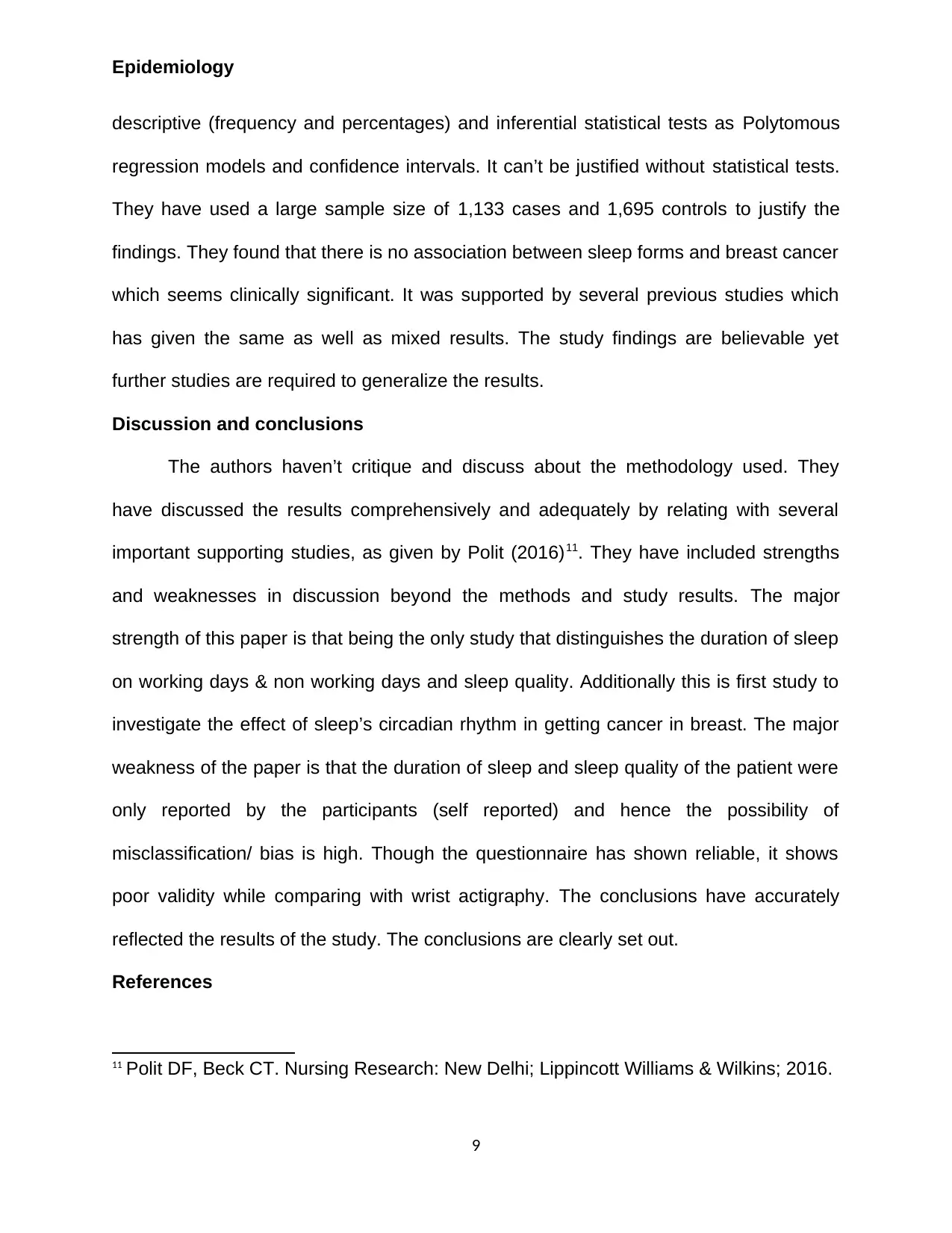
Epidemiology
descriptive (frequency and percentages) and inferential statistical tests as Polytomous
regression models and confidence intervals. It can’t be justified without statistical tests.
They have used a large sample size of 1,133 cases and 1,695 controls to justify the
findings. They found that there is no association between sleep forms and breast cancer
which seems clinically significant. It was supported by several previous studies which
has given the same as well as mixed results. The study findings are believable yet
further studies are required to generalize the results.
Discussion and conclusions
The authors haven’t critique and discuss about the methodology used. They
have discussed the results comprehensively and adequately by relating with several
important supporting studies, as given by Polit (2016)11. They have included strengths
and weaknesses in discussion beyond the methods and study results. The major
strength of this paper is that being the only study that distinguishes the duration of sleep
on working days & non working days and sleep quality. Additionally this is first study to
investigate the effect of sleep’s circadian rhythm in getting cancer in breast. The major
weakness of the paper is that the duration of sleep and sleep quality of the patient were
only reported by the participants (self reported) and hence the possibility of
misclassification/ bias is high. Though the questionnaire has shown reliable, it shows
poor validity while comparing with wrist actigraphy. The conclusions have accurately
reflected the results of the study. The conclusions are clearly set out.
References
11 Polit DF, Beck CT. Nursing Research: New Delhi; Lippincott Williams & Wilkins; 2016.
9
descriptive (frequency and percentages) and inferential statistical tests as Polytomous
regression models and confidence intervals. It can’t be justified without statistical tests.
They have used a large sample size of 1,133 cases and 1,695 controls to justify the
findings. They found that there is no association between sleep forms and breast cancer
which seems clinically significant. It was supported by several previous studies which
has given the same as well as mixed results. The study findings are believable yet
further studies are required to generalize the results.
Discussion and conclusions
The authors haven’t critique and discuss about the methodology used. They
have discussed the results comprehensively and adequately by relating with several
important supporting studies, as given by Polit (2016)11. They have included strengths
and weaknesses in discussion beyond the methods and study results. The major
strength of this paper is that being the only study that distinguishes the duration of sleep
on working days & non working days and sleep quality. Additionally this is first study to
investigate the effect of sleep’s circadian rhythm in getting cancer in breast. The major
weakness of the paper is that the duration of sleep and sleep quality of the patient were
only reported by the participants (self reported) and hence the possibility of
misclassification/ bias is high. Though the questionnaire has shown reliable, it shows
poor validity while comparing with wrist actigraphy. The conclusions have accurately
reflected the results of the study. The conclusions are clearly set out.
References
11 Polit DF, Beck CT. Nursing Research: New Delhi; Lippincott Williams & Wilkins; 2016.
9
⊘ This is a preview!⊘
Do you want full access?
Subscribe today to unlock all pages.

Trusted by 1+ million students worldwide
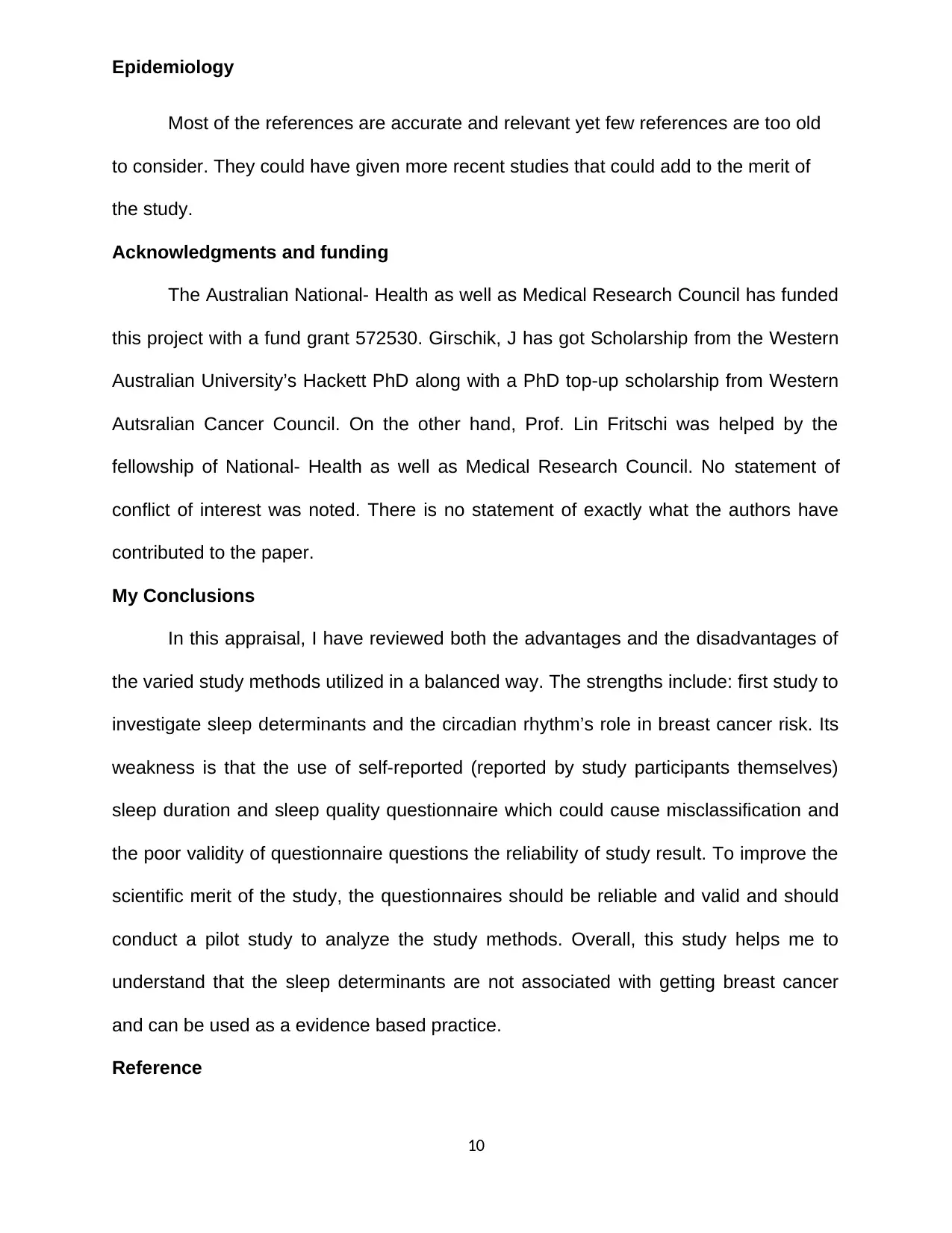
Epidemiology
Most of the references are accurate and relevant yet few references are too old
to consider. They could have given more recent studies that could add to the merit of
the study.
Acknowledgments and funding
The Australian National- Health as well as Medical Research Council has funded
this project with a fund grant 572530. Girschik, J has got Scholarship from the Western
Australian University’s Hackett PhD along with a PhD top-up scholarship from Western
Autsralian Cancer Council. On the other hand, Prof. Lin Fritschi was helped by the
fellowship of National- Health as well as Medical Research Council. No statement of
conflict of interest was noted. There is no statement of exactly what the authors have
contributed to the paper.
My Conclusions
In this appraisal, I have reviewed both the advantages and the disadvantages of
the varied study methods utilized in a balanced way. The strengths include: first study to
investigate sleep determinants and the circadian rhythm’s role in breast cancer risk. Its
weakness is that the use of self-reported (reported by study participants themselves)
sleep duration and sleep quality questionnaire which could cause misclassification and
the poor validity of questionnaire questions the reliability of study result. To improve the
scientific merit of the study, the questionnaires should be reliable and valid and should
conduct a pilot study to analyze the study methods. Overall, this study helps me to
understand that the sleep determinants are not associated with getting breast cancer
and can be used as a evidence based practice.
Reference
10
Most of the references are accurate and relevant yet few references are too old
to consider. They could have given more recent studies that could add to the merit of
the study.
Acknowledgments and funding
The Australian National- Health as well as Medical Research Council has funded
this project with a fund grant 572530. Girschik, J has got Scholarship from the Western
Australian University’s Hackett PhD along with a PhD top-up scholarship from Western
Autsralian Cancer Council. On the other hand, Prof. Lin Fritschi was helped by the
fellowship of National- Health as well as Medical Research Council. No statement of
conflict of interest was noted. There is no statement of exactly what the authors have
contributed to the paper.
My Conclusions
In this appraisal, I have reviewed both the advantages and the disadvantages of
the varied study methods utilized in a balanced way. The strengths include: first study to
investigate sleep determinants and the circadian rhythm’s role in breast cancer risk. Its
weakness is that the use of self-reported (reported by study participants themselves)
sleep duration and sleep quality questionnaire which could cause misclassification and
the poor validity of questionnaire questions the reliability of study result. To improve the
scientific merit of the study, the questionnaires should be reliable and valid and should
conduct a pilot study to analyze the study methods. Overall, this study helps me to
understand that the sleep determinants are not associated with getting breast cancer
and can be used as a evidence based practice.
Reference
10
Paraphrase This Document
Need a fresh take? Get an instant paraphrase of this document with our AI Paraphraser
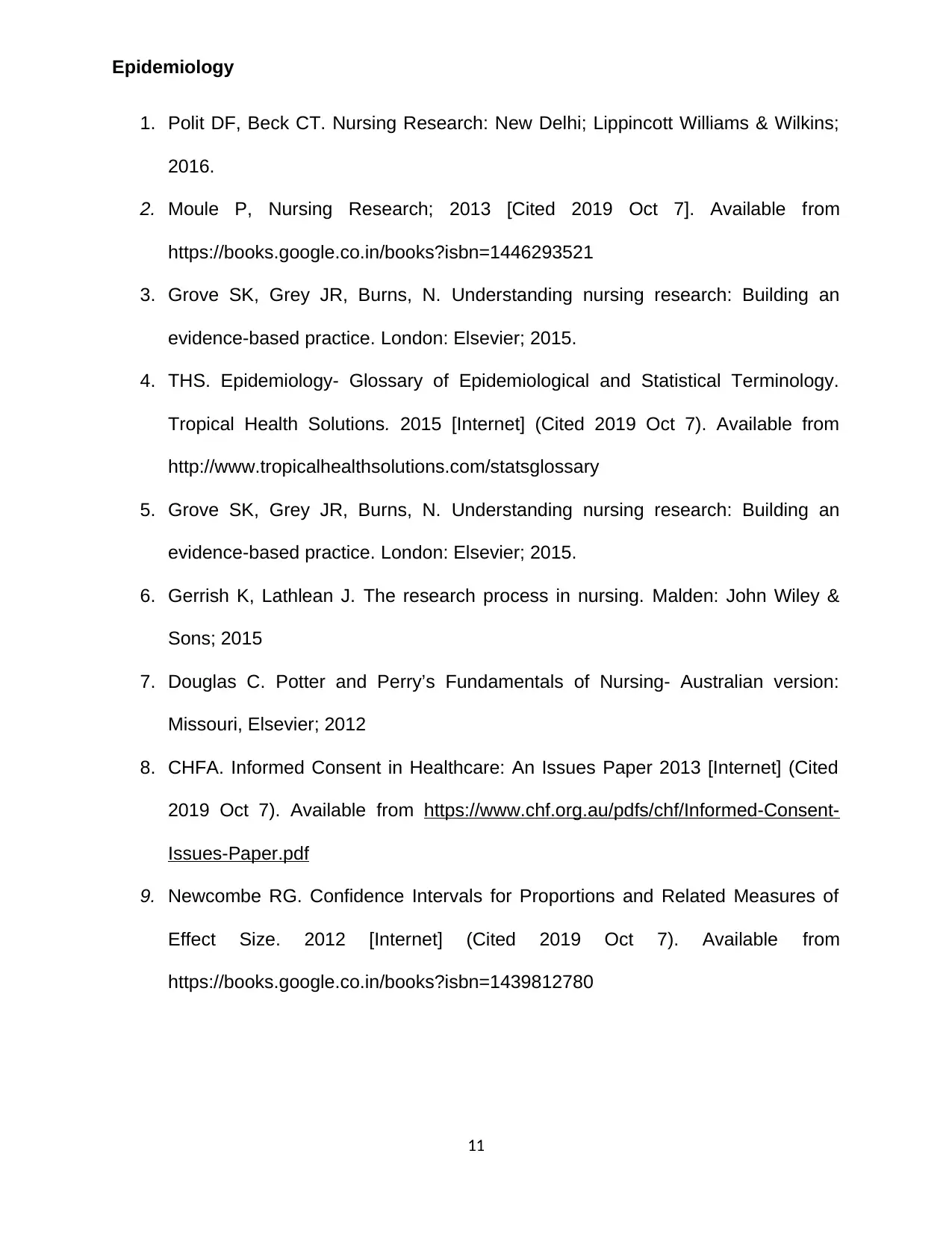
Epidemiology
1. Polit DF, Beck CT. Nursing Research: New Delhi; Lippincott Williams & Wilkins;
2016.
2. Moule P, Nursing Research; 2013 [Cited 2019 Oct 7]. Available from
https://books.google.co.in/books?isbn=1446293521
3. Grove SK, Grey JR, Burns, N. Understanding nursing research: Building an
evidence-based practice. London: Elsevier; 2015.
4. THS. Epidemiology- Glossary of Epidemiological and Statistical Terminology.
Tropical Health Solutions. 2015 [Internet] (Cited 2019 Oct 7). Available from
http://www.tropicalhealthsolutions.com/statsglossary
5. Grove SK, Grey JR, Burns, N. Understanding nursing research: Building an
evidence-based practice. London: Elsevier; 2015.
6. Gerrish K, Lathlean J. The research process in nursing. Malden: John Wiley &
Sons; 2015
7. Douglas C. Potter and Perry’s Fundamentals of Nursing- Australian version:
Missouri, Elsevier; 2012
8. CHFA. Informed Consent in Healthcare: An Issues Paper 2013 [Internet] (Cited
2019 Oct 7). Available from https://www.chf.org.au/pdfs/chf/Informed-Consent-
Issues-Paper.pdf
9. Newcombe RG. Confidence Intervals for Proportions and Related Measures of
Effect Size. 2012 [Internet] (Cited 2019 Oct 7). Available from
https://books.google.co.in/books?isbn=1439812780
11
1. Polit DF, Beck CT. Nursing Research: New Delhi; Lippincott Williams & Wilkins;
2016.
2. Moule P, Nursing Research; 2013 [Cited 2019 Oct 7]. Available from
https://books.google.co.in/books?isbn=1446293521
3. Grove SK, Grey JR, Burns, N. Understanding nursing research: Building an
evidence-based practice. London: Elsevier; 2015.
4. THS. Epidemiology- Glossary of Epidemiological and Statistical Terminology.
Tropical Health Solutions. 2015 [Internet] (Cited 2019 Oct 7). Available from
http://www.tropicalhealthsolutions.com/statsglossary
5. Grove SK, Grey JR, Burns, N. Understanding nursing research: Building an
evidence-based practice. London: Elsevier; 2015.
6. Gerrish K, Lathlean J. The research process in nursing. Malden: John Wiley &
Sons; 2015
7. Douglas C. Potter and Perry’s Fundamentals of Nursing- Australian version:
Missouri, Elsevier; 2012
8. CHFA. Informed Consent in Healthcare: An Issues Paper 2013 [Internet] (Cited
2019 Oct 7). Available from https://www.chf.org.au/pdfs/chf/Informed-Consent-
Issues-Paper.pdf
9. Newcombe RG. Confidence Intervals for Proportions and Related Measures of
Effect Size. 2012 [Internet] (Cited 2019 Oct 7). Available from
https://books.google.co.in/books?isbn=1439812780
11
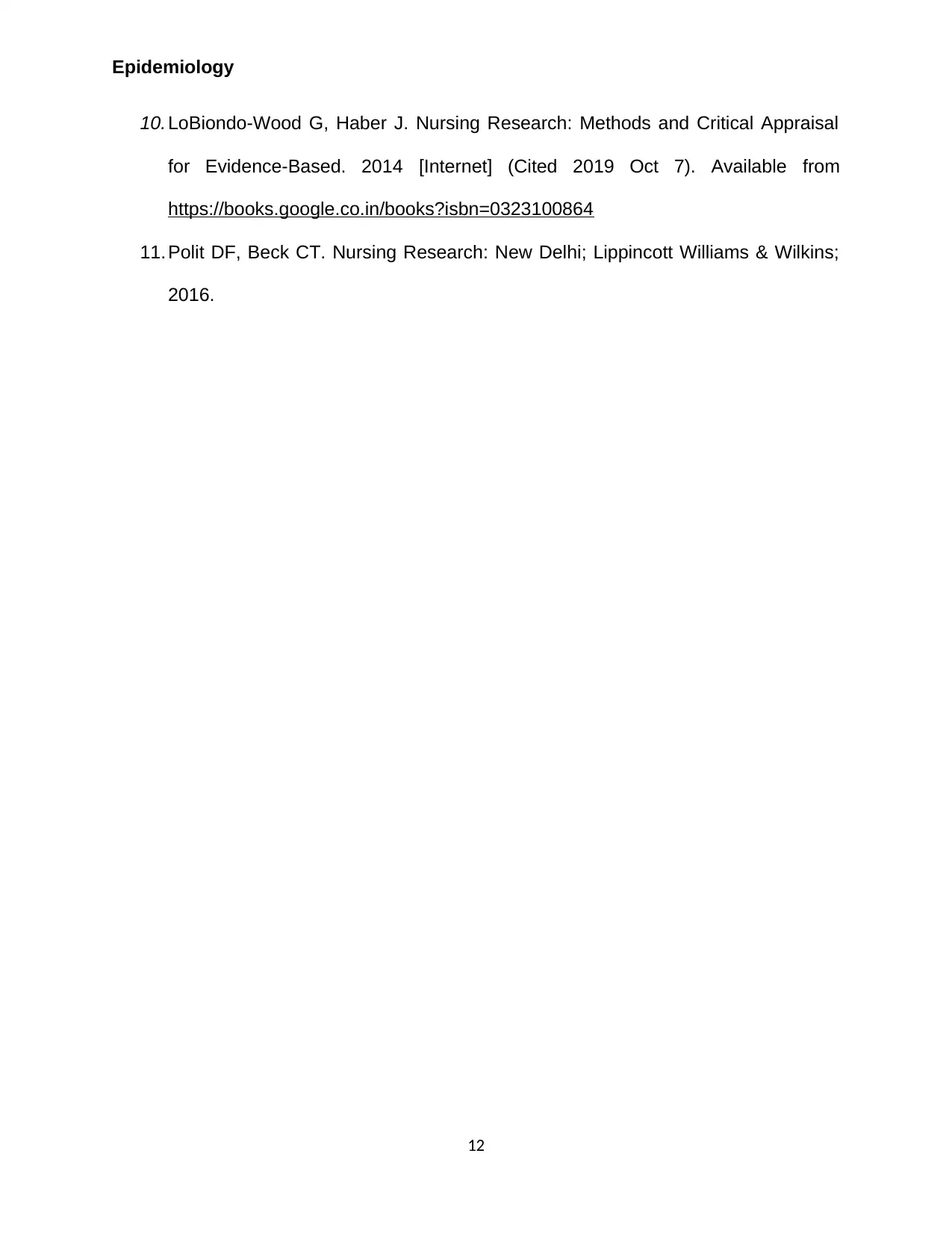
Epidemiology
10. LoBiondo-Wood G, Haber J. Nursing Research: Methods and Critical Appraisal
for Evidence-Based. 2014 [Internet] (Cited 2019 Oct 7). Available from
https://books.google.co.in/books?isbn=0323100864
11. Polit DF, Beck CT. Nursing Research: New Delhi; Lippincott Williams & Wilkins;
2016.
12
10. LoBiondo-Wood G, Haber J. Nursing Research: Methods and Critical Appraisal
for Evidence-Based. 2014 [Internet] (Cited 2019 Oct 7). Available from
https://books.google.co.in/books?isbn=0323100864
11. Polit DF, Beck CT. Nursing Research: New Delhi; Lippincott Williams & Wilkins;
2016.
12
⊘ This is a preview!⊘
Do you want full access?
Subscribe today to unlock all pages.

Trusted by 1+ million students worldwide
1 out of 12
Related Documents
Your All-in-One AI-Powered Toolkit for Academic Success.
+13062052269
info@desklib.com
Available 24*7 on WhatsApp / Email
![[object Object]](/_next/static/media/star-bottom.7253800d.svg)
Unlock your academic potential
Copyright © 2020–2025 A2Z Services. All Rights Reserved. Developed and managed by ZUCOL.





